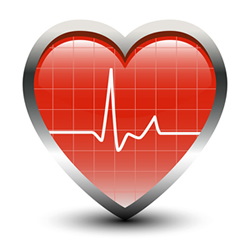Heart Rate Based Calorie Burn Calculator

This heart rate based calorie burn calculator (also known as a "heart rate based caloric expenditure calculator") provides an estimate of the rate at which you are burning calories during aerobic (i.e. cardiorespiratory) exercise, based on your average heart rate while performing the exercise.
During exercise your muscles must burn calories to fuel their contractions. The conversion of calories from their stored nutrient state to the form that can be burned by your muscle cells is achieved, during aerobic exercise, through the process of cellular respiration, which requires oxygen, and the delivery of oxygen through your bloodstream to your active muscle cells is directly related to your heart rate. It is this relationship that allows you to predict your energy expenditure (i.e. calorie burn) from your heart rate. Essentially, with increased exercise intensity your muscles must burn more calories, and so your heart must beat faster to provide the oxygen necessary to convert those calories to the form of energy that can be burned by your muscles.
Method
This calculator is based on the equations (shown below) derived by LR Keytel, JH Goedecke, TD Noakes, H Hiiloskorpi, R Laukkanen, L van der Merwe, and EV Lambert for their study titled "Prediction of energy expenditure from heart rate monitoring during submaximal exercise."
The experimental data on which this calculator is based covers an exercise intensity level that ranges from between 41% to 80% of VO2max. The calculator will not provide an estimate of heart rate based caloric expenditure below 41% of VO2max (or roughly 64% of maximum heart rate according to the Swain et al. correlation) because the relationship between heart rate and caloric expenditure is not considered to be reliable below the test data lower limit. The calculator does, however, provide an estimate of heart rate based caloric expenditure above the test data upper limit of 80% of VO2max (or roughly 89% of maximum heart rate according to the Swain et al. correlation), up to a maximum heart rate of 200 beats per minute, to enable users with above average maximum heart rates, and those exercising at high intensity levels, to make use of the calculator. Users should therefore note that any estimation of calorie burn above 80% of VO2max (or roughly 89% of maximum heart rate) is based on an extrapolation (i.e. an assumption that the data correlation holds outside the limits of the gathered data points) of the experimental data rather than an interpolation.
To ensure that you are performing a calorie burn estimate above the lower intensity limit of 41% of VO2max permitted by this calculator, a correlation between heart rate and VO2max is used within the calculator to convert the heart rate input from users to a percentage of VO2max. A determination of maximum heart rate is performed based on the formula defined by H Tanaka, KD Monhan, and DG Seals in their study titled "Age-predicted maximal heart rate revisited" and, subsequently, a conversion from percentage of maximum heart rate to percentage of VO2max is performed according to a linear regression formula (shown below) derived by ShapeSense.com from experimental data gathered by DP Swain, KS Abernathy, CS Smith, SJ Lee, and SA Bunn for their study titled "Target heart rates for the development of cardiorespiratory fitness."
Equations
Equations for Determination of Calorie Burn if VO2max is Unknown
- Male: ((-55.0969 + (0.6309 x HR) + (0.1988 x W) + (0.2017 x A))/4.184) x 60 x T
- Female: ((-20.4022 + (0.4472 x HR) - (0.1263 x W) + (0.074 x A))/4.184) x 60 x T
where HR = Heart rate (in beats/minute) W = Weight (in kilograms) A = Age (in years) T = Exercise duration time (in hours)
Equations for Determination of Calorie Burn if VO2max is Known
- Male: ((-95.7735 + (0.634 x HR) + (0.404 x VO2max) + (0.394 x W) + (0.271 x A))/4.184) x 60 x T
- Female: ((-59.3954 + (0.45 x HR) + (0.380 x VO2max) + (0.103 x W) + (0.274 x A))/4.184) x 60 x T
where HR = Heart rate (in beats/minute) VO2max = Maximal oxygen consumption (in mL•kg-1•min-1) W = Weight (in kilograms) A = Age (in years) T = Exercise duration time (in hours)
Equation for Determination of Maximum Heart Rate Based on Age
- Maximum Heart Rate (beats/minute) = 208 - (0.7 x Age)
Equation for Exercise Intensity Conversion from %MHR to %VO2max
- %VO2max = 1.5472 x %MHR - 57.53
where %MHR = Percentage of maximum heart rate %VO2max = Percentage of VO2max
Keytel LR, Goedecke JH, Noakes TD, Hiiloskorpi H, Laukkanen R, van der Merwe L, Lambert EV. Prediction of energy expenditure from heart rate monitoring during submaximal exercise. J Sports Sci. 2005 Mar;23(3):289-97.
Swain DP, Abernathy KS, Smith CS, Lee SJ, Bunn SA. Target heart rates for the development of cardiorespiratory fitness. Med Sci Sports Exerc. January 1994. 26(1): 112–116.
Tanaka, H., Monhan, K.D., Seals, D.G., Age-predicted maximal heart rate revisited. Am Coll Cardiol 2001; 37:153-156.